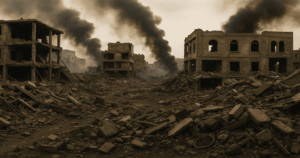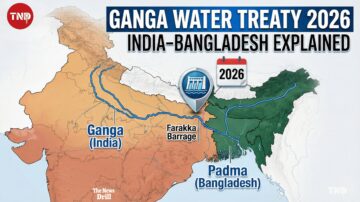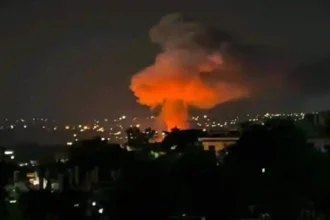Ceasefire Halting the 12‑Day War
Trump brokered truce: On June 23, U.S. President Donald Trump announced a “complete and total ceasefire” between Israel and Iran, with a phased start: Iran halted strikes at 00:00 GMT, Israel followed 12 hours later.
- Ceasefire Halting the 12‑Day War
- Military Actions & Capabilities Struck
- Humanitarian Cost & Regional Fallout
- U.S. Diplomatic & Strategic Role
- Widespread Destruction on Both Sides
- Inside Iran: Nuclear, Military & Civilian Impact
- In Israel: Cities Under Siege
- Infrastructure Collapse
- What Comes Next?
- Bottom Line
Early violations: Both nations carried out attacks Israel struck a radar site near Tehran; Iran responded with missile launches targeting Beersheba before pulling back after Trump’s urgent reminders to respect the agreement.
Ceasefire holding for now: Satellite imagery shows no active strikes in recent hours; tensions remain high, but a fragile calm persists.
Military Actions & Capabilities Struck
U.S. Strikes on Iranian Nuclear Sites
Scope of strikes: On June 22, the U.S., in coordination with Israel, bombed Fordow, Natanz, and Isfahan – Trump claimed a complete obliteration, but U.S. intelligence suggests only limited damage, setback measured in months, not years . The IAEA described the impact as “night and day.”
Israeli Operations
Operation Rising Lion: Beginning June 13, Israel launched a campaign targeting over 100 nuclear/military sites, including Tehran’s missile infrastructure, supported by covert Mossad drone sabotage deep inside Iran.
Iranian Strikes
Missile barrages: Iran launched over 150 ballistic missiles and dozens of drones at Israel starting June 13.
The most impactful strike hit Soroka Medical Center in Beersheba, injuring civilians and causing chemical leaks.
Limited U.S. involvement: Iran also fired missiles at U.S. al Udeid Air Base in Qatar on June 23 (Operation “Glad Tidings of Victory”), with prior warning given six missiles hit or were intercepted; no casualties.
Humanitarian Cost & Regional Fallout
Civilian toll: Iran reported 610 civilian deaths; Israel recorded at least 4 off-duty soldiers killed in missile strikes . The hospital strike in Beersheba intensified humanitarian concerns.
Regional disruption: Airspace closures across Israel, Syria, and Gulf nations lifted post-ceasefire. Global oil prices dropped (~3 – 3.4%) and markets rallied on ceasefire news.
U.S. Diplomatic & Strategic Role
Peace broker: The U.S. played a pivotal role in launching strikes, securing a ceasefire, and defusing violations through direct pressure on both Israel and Iran.
Domestic politics: Republicans largely supported the strikes; Democrats criticized the executive action as risky and potentially unconstitutional without Congressional approval.
Nuclear diplomacy: Negotiations may resume soon Pentagon and IAEA assessments suggest neither full obliteration nor unstoppable progress, leaving room for talks.
Widespread Destruction on Both Sides
The 12-day war between Israel and Iran left a trail of destruction unprecedented in recent regional conflicts. With more than 300 airstrikes, ballistic missile launches, and sabotage operations, the damage extended far beyond military targets crippling infrastructure, endangering civilians, and igniting regional fears.
Inside Iran: Nuclear, Military & Civilian Impact
Nuclear Sites Targeted: U.S. and Israeli forces launched precision strikes on Fordow, Natanz, and Isfahan nuclear facilities. While not entirely destroyed, these strikes set Iran’s uranium enrichment capabilities back by an estimated 12–18 months.
Tehran Under Fire: Multiple drone attacks, reportedly orchestrated by Mossad, struck Iranian military command centers and weapons depots deep inside Tehran. Several residential areas were also hit due to failed intercepts.
Civilian Casualties: Over 600 civilians were reported dead across Iran, with major blackouts in Isfahan and Qom. Hospitals were overwhelmed, and critical medical supplies ran short within days.
In Israel: Cities Under Siege
Missile Barrages: Iran responded with over 150 ballistic missiles, targeting Israeli cities including Beersheba, Ashdod, and Dimona. Israel’s Iron Dome and David’s Sling intercepted most, but some penetrated, causing serious damage.
Hospital Strike: The most devastating hit was on Soroka Medical Center in Beersheba. While the hospital wasn’t completely destroyed, parts of its emergency unit collapsed, killing patients and staff.
Chemical Leaks: One missile reportedly struck a chemical plant near Ashkelon, causing hazardous leaks and triggering mass evacuations in surrounding areas.
Infrastructure Collapse
Airports Shut: Tel Aviv’s Ben Gurion Airport and Tehran’s Mehrabad Airport were closed for days. Airspace over the eastern Mediterranean and Persian Gulf became militarized zones.
Communications Cut: Satellite networks and mobile internet services were jammed or disabled during peak fighting, especially in southern Iran and central Israel.
What Comes Next?
Ceasefire durability: Holding for now, but any violation could unravel the fragile calm. International actors like Europe and the U.N. urge renewed diplomacy while urging restraint.
Iran’s nuclear resilience: While damaged, Iran is reportedly repairing facilities. The U.S. must decide between containment or renewed diplomatic engagement.
Regional balance: Israel recaptured operational depth; Iran demonstrated its ability to strike high-profile targets; the U.S. balance of force and diplomacy shapes future outcomes.
Bottom Line
The 12 day war paused but underlying tensions, strategic recalibrations, and political fault lines remain. The U.S. stands at the center as both military actor and peace broker with its decisions now critical for regional and nuclear futures.
Stay tuned with The News Drill for more updates.
Contact us: contact@thenewsdrill.com








